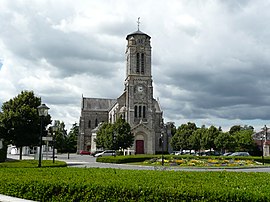Les Lucs-sur-Boulogne
Les Lucs-sur-Boulogne | |
|---|---|
 The church in Les Lucs-sur-Boulogne | |
 Coat of arms | |
show Location of Les Lucs-sur-Boulogne | |
 Les Lucs-sur-Boulogne | |
| Coordinates: 46°50′42″N 1°29′32″W / 46.845°N 1.4922°WCoordinates: 46°50′42″N 1°29′32″W / 46.845°N 1.4922°W | |
| Country | France |
| Region | Pays de la Loire |
| Department | Vendée |
| Arrondissement | La Roche-sur-Yon |
| Canton | Aizenay |
| Intercommunality | Vie et Boulogne |
| Government | |
| • Mayor (2020–2026) | Roger Gaborieau[1] |
| Area 1 | 53.15 km2 (20.52 sq mi) |
| Population (Jan. 2018)[2] | 3,498 |
| • Density | 66/km2 (170/sq mi) |
| Time zone | UTC+01:00 (CET) |
| • Summer (DST) | UTC+02:00 (CEST) |
| INSEE/Postal code | 85129 /85170 |
| Elevation | 29–80 m (95–262 ft) |
| 1 French Land Register data, which excludes lakes, ponds, glaciers > 1 km2 (0.386 sq mi or 247 acres) and river estuaries. | |
Les Lucs-sur-Boulogne is a commune in the Vendée department in the Pays de la Loire region in western France.
History[]
The site's origins date from the Gallo-Roman period. According to the etymology, the name Lucus meant "Sacred Wood". This implantation is thought to have been an important religious site among local Celtic populations. A stone altar from this period that would have served for a Druidic cult has also been found at Motte du Petit-Luc.
The Lucs-on-Boulogne is famous for the massacre of its population, according to some historians on 28 February 1794, by the infernal columns during the Wars of the Vendée. The mortuary plates of the chapel of Petit Luc bear the names of 564 people massacred on this occasion.
On the occasion of his inauguration, Alexander Solzhenitsyn made a speech in which he drew a parallel between the spirit that animated the politicians applying the Terror and Soviet totalitarianism.
A law dated June 18, 1861 allocates part of the territory of the commune of Lucs-sur-Boulogne to Legé, in the Loire-Inferior, modifying the limits of the departments.
See also[]
References[]
- ^ "Répertoire national des élus: les maires". data.gouv.fr, Plateforme ouverte des données publiques françaises (in French). 2 December 2020.
- ^ "Populations légales 2018". INSEE. 28 December 2020.
| Wikimedia Commons has media related to Les Lucs-sur-Boulogne. |
- Communes of Vendée
- Vendée geography stubs


